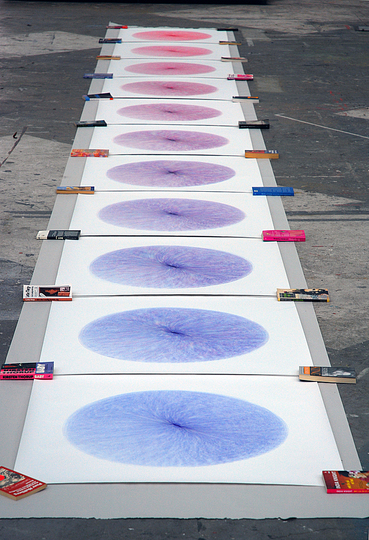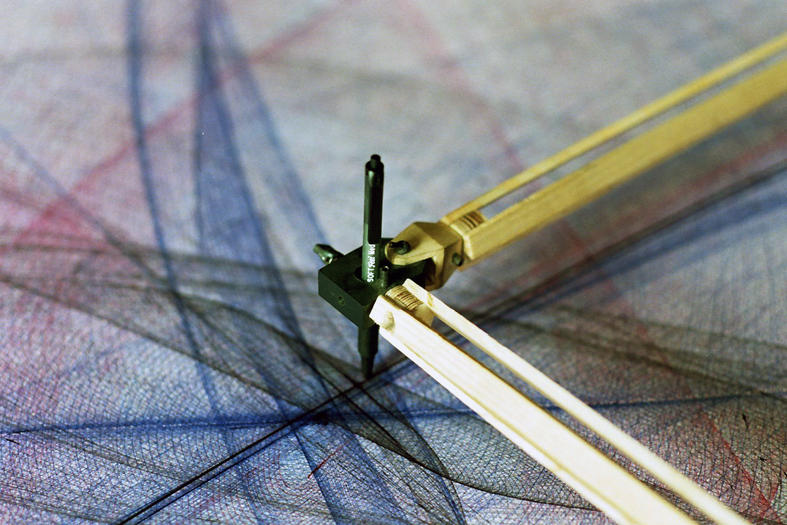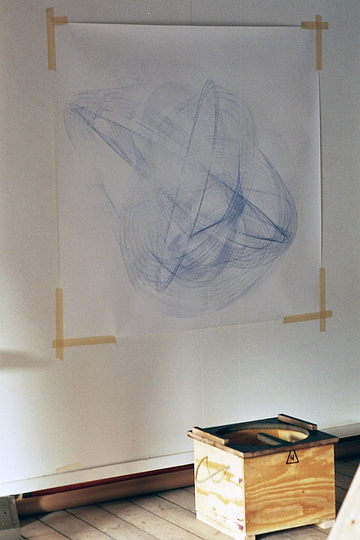Drawing machine
www.eskerex.com
In 2011, Eske Rex’s Drawing Machine occupied the entire basement floor of the Mindcraft space in Milan. A showcase for the long-lasting dialog between design and craft in Denmark, for the last two years Mindcraft has been curated by Cecilie Manz who chose to center the exhibition concept on quality, materiality and functionality – a statement, which, in her opinion, sums up the essence of Danish-ness in design. The Drawing Machine presented itself as a somewhat rustic device consisting of two wooden structures, each supporting a pendulum with stone weights, set in motion by hand. The pendulums were connected to a ballpoint pen through «drawing arms»; their motion translated into the pen’s circular movements across a vast spread of paper.
This was definitely a story of functionality – dealt with in a manner that is as direct as can be. A cup or a chair can (should) be functional because we use them for specific tasks, but the Machine was simply about functioning. About defining the proportions of the device and adjusting the weights, smartly hooked on the side of the supporting frame for instant availability. About pushing the pendulums so that their coordinated movement will produce a drawing. About transmitting an effort from man to mechanism to pen. Apparently, this attitude towards function comes from an interest in natural forces that galvanize the object with dynamics and tension, and in different kinds of reproducing natural phenomena. This year, Manz suggested Eske Rex to explore the theme of gravity. The new Mindcraft exhibition was laid out along two parallel walls, and Rex had to provide a connection between them. In search for a minimalist solution, the artist turned to magnetic power, which held in suspension a thread stretched across the room and terminated by a wooden trumpet nearly touching the opposite wall. At the beginning, you were only impressed by the thinness and length of the thing that stretched across a 5-6 m span, and only then you realized that it actually floated in the air, leaving a gap between the object and the wall – a connection that turned out to be a non-connection.
Eske Rex has placed himself between three fields: art, design and architecture (he studied both art and design). Add to this an experience in carpentry – hence the interest in scale and construction. «Not that I am trying to connect them all; that’s just the way I am,» says Rex who needs an outlet for experimenting somewhere on the border between the functional and the unrestricted by pragmatic concerns; between designing precisely calculated structures and working with the forces he can only control to a certain extent. «Nature comes in here. A swinging pendulum can do something I could not have done even if I were a skilled draftsman or a computer geek; the nature still does it better. And then, it has this fantastic poetic feel: you can work, and think, and sketch, and build – and then you launch it and just see it happen. No two drawings will be the same; the machine will always work differently depending on how you start it, or how much weight you apply to the pendulum.»
The «end product» of the Machine may be the drawing but the star of the show is obviously the device that has produced it. «When you exhibit drawings alone, there is always this question of where they come from; it is clear that these forms are not created by a computer, but one also feels that they are not hand drawn. To me, the Drawing Machine is both a tool and a moving sculpture, an installation in space. When it’s not on show I use it for making further experiments.» While the greyscale Fibonacci series deals with interference patterns whose complexity increases the longer the machine works on them, the new set of drawings explores colour gradients. Rex relates these experiments to Joseph Albers’ investigations into the nature of colour and movement. Then again, large-scale drawings become a spatial experience, which varies with the distance between the viewer and the artwork, revealing its finesse as you get closer. And from here, there is just one step to researching into the possibilities of cooperation between art and architecture. What would Eske Rex do if commissioned to create some site-specific art for an architectural project? – He would prefer to be there from the start instead of designing an art piece for an already completed space. He needs «to play with the program, to work together with architects on the dimensions of the space and the way it is developed…» This will be a kind of incorporated art, maybe with a specific function, «because art can really be functional. It can show the way, or make a space stronger.»
Monitor magazine interview 2012 by Anna Yudina.
Inspirations.
Les Concerts du mercredi
The idea of Swiss based graphic design practice We Play Design for these posters for Les Concerts du...
Tatsuo Miyajima: Being Coming
Although this is for an exhibition of Japanese contemporary artist Tatsuo Miyajima at Shanghai Minsh...
Yokohama Museum of Art Calendar
Graphic designers Aizawa office from Yokohama designed this wall calendar. With its unassuming but a...
Pulp Fiction
A selection of American and Mexican Pulp Fiction covers from the nineteen-forties.
Architectural sculptures
Architectural sculptures by K. Kegelmann as part of "Future City" curated by Mario Gagliardi at the ...
Synthetic Paradise
Generative music combined with abstract graphics. Click the screen to generate new graphics:
https:/...
Francesco Vezzoli: Antique not Antique
Francesco Vezzoli at MUSEO MUSEION.
Surrealism
Inspired by Surrealism and some of the artists of that time (such as Dali or Ernst), I created basic...
Back in the USSR
Great retro logos from the old USSR, and a Beatles song.
https://soundcloud.com/thebeatlesrevisited...
Faces by 田中 一光 Ikko Tanaka
Inspired by the Bauhaus, by Jazz and by American graphic design, Ikko Tanaka (1930-2002) was one of ...
Arte generativo
Ejemplos de arte generativo que sirvan de inspiración
Rudolf Belling
Rudolf Belling was sculptor, designer, architect and stage designer. In 1908, he founded a studio fo...
penccil
Concept, branding, design and coding of penccil, the site for creative people, studios and gallerie...
Pattern generator
A generator for tile and fabric patterns. Drag and drop images and see kaleidoscopic patterns emerge...
CoBrA Magazines
The avant-garde art collective CoBrA (Copenhagen, Brussels and Amsterdam) existed from 1949 to 1951....
Cognition
This experiment looks at the process of human cognition. Letters get progressively filled with color...
I See Violence in Your Eyes (I-VIII)
Pigment, graphite, charcoal, & mixed media on paper.
Trajectories of the Lost, Fallen, Forgotten, and Most Unclean
Ink, graphite, pigment, & mixed media on paper.
Alessandro Mendini 1931-2019
For Alchimia, design is a cyle: everything that will have to happen has already happened, and the im...
VAW
In late 2018, we proposed a strategic repositioning of Vienna Art Week.
We suggested a fundamental...
Pieter Bruegel
During his lifetime, Pieter Bruegel the Elder was already among the period’s most sought-after art...
Territorium: Ars - Techne-Krafts-Cosmovisión
Colección de imágenes que soportan investigación a nivel de postgrado: Maestría
Estudios Territ...
Writing & Design
Bohemian Crossroads: Art & Culture Collide Then Subside. Writer and Designer.
Writing & Design
Bohemian Highways: Abide Then Divide Along the California Coast. Writer and Designer.
Writing & Design
Horizon Homes: Living a Concrete Dream. Writer and Designer, Ted Wells.
Writing & Design
Artists Abroad: A Woman´s Journey to Discover the Artists. Writer and Illustrator.
Writing & Design
Bohemian Bridges: California as a Superstructure for Social and Cultural Change. Writer and Designer...
Writing & Design
SQT..or Not. Book. Writer and Illustrator, Ted Wells.
WRECK--Regeneration Experiment of Wasted Daily-use Ceramics from Chaozhou, China
WRECK, the destruction of decorum, the ruin of culture. BENTU went deep into daily-use ceramics indu...
The loft bar
Concept project of loft bar.
Stories of You
REVOIR is an interactive mirror, activated by emotion detection to create stories through visual lan...
Exiled from Truth: Nine Allegories by Dmitry Borshch
"Exiled from Truth: Nine Allegories by Dmitry Borshch"
105 NY-110, Melville, NY 11747
July 10, 11 a...
One Hundred Thousand Games
One Hundred Thousand Games is an online game with unlimited levels. It takes the genre of first-per...
Art Driver
A obstacle driving computer game with visual art. Use the arrow keys on your keyboard to push obsta...
The Joys of Ice Skating
That skating 400 years ago was one of the most popular winter activities in the Netherlands can be s...
penccil: This was 2017
The penccil year in review is a project selection for 2017, this year curated by Mario Gagliardi. Se...
Cutting the edges
Arctic Paper launches new swatch books for the brands Arctic, Amber and G-Print, as well as the two ...
The pattern of You
Each name results in a unique pattern. The pattern and colors created are unique to each name, and t...
serpentine 2017
exhibition, schauspiel köln, cologne. steelobjects, ceramic reliefs.
BS1
temporary accessible sculpture.
We Ar
University of Sunderland MA Glass and Ceramics Show
Maurice Binder
Maurice Binder was a film title designer best known for his work on 14 James Bond films including th...
Neverending Graphics
Graphics and animations are generated on the fly, resulting in perpetual variations. Move your mouse...
Le Drugstore Brand Identity
Design&Practice designed the brand identity for the newly opened restaurant "Le Drugstore," with int...
Coffee maker
Visualization of the process of coffee making.
The aim was not to use words.
FASHION ADVERTISING
RESEARCH
ILLUSTRATION
RESEARCH
UNTITLED PROJECT: CABIN [THOREAU]
UNTITLED PROJECT: CABIN [THOREAU] [ANGLET], 2016 –– a carved and painted replica of Henry David ...
Untitled Project: Honda CB77 Superhawk
UNTITLED PROJECT: HONDA CB77 SUPER HAWK, oil paint on carved wood, 2013-2014 –– A carved/painted...
Geigy, Swiss and European Graphic Design
Selection of outstanding graphic design from Europe
ARCHITETTURA ANALOG(IC)A massimo gasperini
MASSIMO GASPERINI_(Pisa, 1971) architect and researcher in the Representation Sciences, former lectu...
Franz Kline
Around 1950, Franz Kline radically simplified painting: “Instead of making a sign you can read, yo...
Book : Monk
A book by Jonathan Monk.
Book : Tajima
A book by Mika Tajima.
Negative Entropy is a series of five abstract Jacquard woven portraits of in...
Book : Lewitt
A book by Sam Levitt.
TEMPLATE is a book whose information emerges under programmatic erasure. Or p...
Book : Baldessari
A book by John Baldessari.
Book : Armleder
A book by John Armleder.
Book : Mullican
A book by Matt Mullican.
Book : Weiner
A book by Lawrence Weiner.
Book : Cattelan
A book by Maurizio Cattelan.
Book : Brannon
A book by Matthew Brannon.
New Generation
Experiemntal art
The Menu
The food menu as we know it today is an invention of the 19th century. Traditionally, during a meal ...
What Is A Simulation?
What is a simulation?
It is a private game we devise when the aliveness of a situation is too comple...
The algorithm of fashion
Each of these scarf patterns is unique. The production workflow involves an algorithm which creates ...
The art of improvising art
The recently abandoned administrative headquarters of Austrian Post, an imposing turn of the century...
Books of Memory: Gianpaolo Pagni
Gianpaolo Pagni creates unique, printed, painted or stamped books. His work focuses around memory an...
Groupe Garcia Ingénierie
Corporate identity. Marseille, France, 2015.
Just Before Paradise
“And just as we learn about our lives from others, so, too, do we let others shape our understandi...
Expression/Information
Painting is seen as a form of practice that—contrary to canonical accounts—in no way shies away ...
also:
drawings
sneak peek
Earth Works
Multi-collage research, between objects, land art and drawing.
Field of Notion
Field of Notion delves into the dichotomies of light and shadows, life and death, creating a series ...
Trompe l´oeil
Rugs "Trompe l´oeil".
Design: Mario Gagliardi for Mario and Casa.
gift: 礼物
gift, color on paper, by zhu yuzhou, 2022.
Eden
Paper sculpture
Choreography of pictorial fetishes
Afterword by WM Hunt
These are photographs.
These exist uniquely as photographs. The artist, Manuel ...
McDEAD ..and lovin' it!
In Australia we call McDonalds - Maccas.
Maccas holds a special place in my heart... it's called cho...
MILEY CYRUS is a ZOMBIE
This is an unused piece for the Australian comic ZOMBIE CITIES by Zorab del Rio.
I can understand to...
TOKYO ZOMBIES
This is the inks for TOKYO ZOMBIES,
a piece I did for the Australian comic called ZOMBIE CITIES by ...
SPACE GIRL
Comic Art, Illustration, Art, Line Art, Brush, Comics.
PAISAJES DE L'EMPORDÀ
Collage
CROMOS
Collage
SALTO
Sculpture
HISTORIA DE UN HUEVO
Sculpture
PERSONAJES
Collage
EL CAMINO MÁS LARGO
Sculpture
ADELA
Sculpture
SÚBER
Sculpture
EL PAPEL DE LA FAMILIA
Ilustraciones para artículo: El Papel de la Familia (Hospital Sant Joan de Déu) 2023
VIENTO EN POPA
Mixed Technique
PINTAORA
Painting
EQUILIBRIOS
Escultura
Shop Them - DR NOKI T-shirts are here!
penccil is happy to announce its launching of penccil shop <t https://penccil.com/shop with fashion ...
Pianeti
Rug set "Pianeti", designed by Mario Gagliardi for Mario and Casa. Handcrafted in 100% New Zealand M...
curve wood
Title is affranchir la ligne, a public art commission for the lobby of a sports complex, plays with...
briller par son absence
burn wood
Surface N° 2
Arctic Paper presents Surface N° 2 – a second edition featuring a specially curated selection of ...
The Frenchness of Russian Art: Montaigne and Death
"The Frenchness of Russian Art: Montaigne and Death"
105 NY-110, Melville, NY 11747
September 13, 1...
Coloured stones
The coloured stones is use Traditional Chinese Taihu Stone
The painted house
These experimental structures have been created by combining design processes of architecture and gr...
SCARABOOK
SCARABOOK is the combination of Scarabottolo and the English word book (but perhaps we ought to say ...
My calendar
I start to make it in 2000, the year in which the future has passed, at the request of Adriano Mei G...
71 views of the magic mountain
In the days of the first lockdown I started making these drawings, remotely inspired by Hokusai´s "...
on paper books and e-books
these drawings were made thinking about what is happening to the books through various titles of cla...
The Demonstrations series.
A new series of paintings, oil on canvas, that deal with movement, the power and energy of the crowd...
Curtains
A series of watercolour paintings.
Ebb and Flow
This student design project smartly uses paper to give shape to the intertidal coastline of Taiwan, ...
Culinary Tradition
Four examples of contemporary food packaging designs inspired by traditional Chinese patterns and gr...
TRIAL
Old-school postal packaging usually gets little attention from graphic designers. Not so in this fun...
Archip-elles
Swiss graphic designers We Play created this pop-art inspired, fun poster series for the Archipelles...
Kids House
For Inwayi Kids House in Ningbo City, China, designer Nono Xia of graphic design studio Ninemix cam...
The modern artist is working with space and time, and expressing his feelings rather than illustrating.
— Jackson Pollock
— Jackson Pollock
- penccil is free.
- No trackers. No cookies.
Just creativity.

























